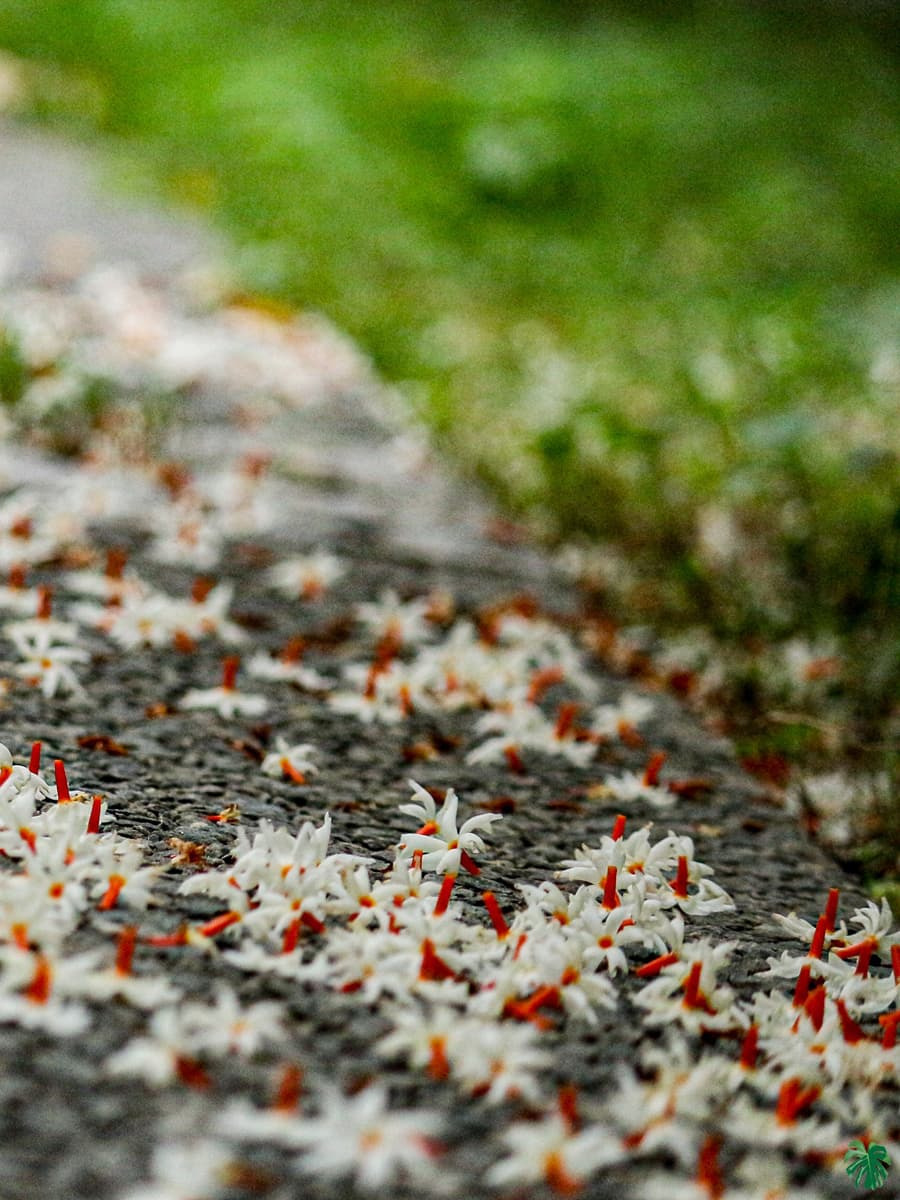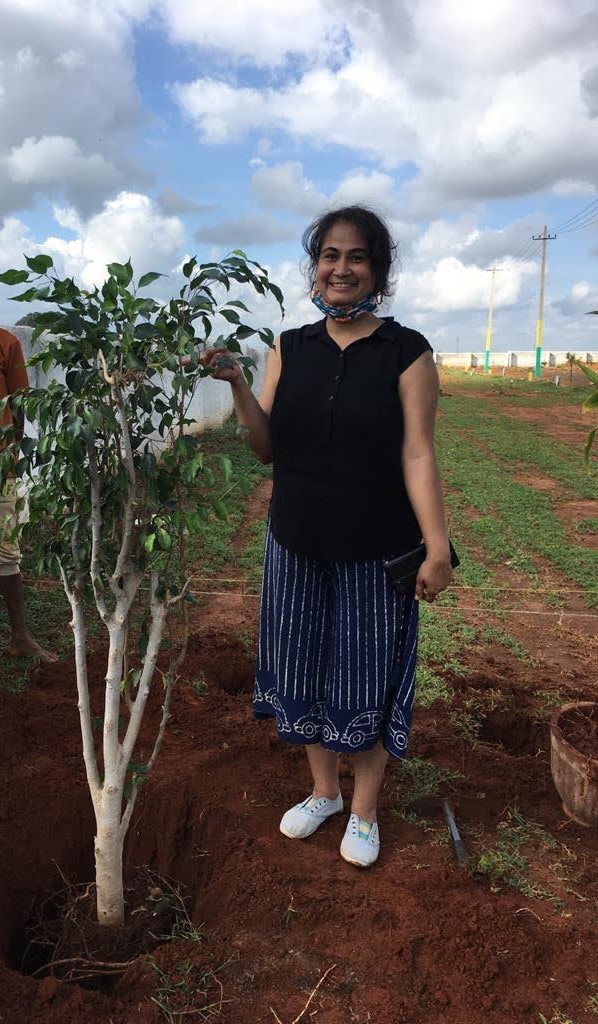The trees of my childhood

The trees of my childhood and the bushes and the plants, they come alive sometimes in the night of my adulthood, through the darkness of my sleep, seamlessly blending over the years, pressing their cloying fragrances and textures and tastes and memories that seem to have no sense of time. Fruits and flowers, leaves and earth flooding my senses.
The earliest memory I have is of the Parijatha, Pavazha Malli we called them. In the night the tree would come abloom, spreading its heady fragrance in the twilight. It was a small twisted tree and we had to shake it ever so gently, for it to rain its white and orange pearls to the ground. And, your earliest baptism into gentleness was in learning to pick them up holding them by their orange stems without bruising the white petals. I must have been three or four years old then.
In the corner on the right was the Arali, which did not flower then, but is crowned with pink blooms now. I do distinctly remember a hibiscus tree beside the ledge I used to play and run an imaginary home.
The left of the house held the lilies and the roses. The small button roses and the strong scented Edward roses. On the rare birthdays, they would bloom right on the day and I remember a few birthdays being woken up to the smell of the Edward rose pressed close to my nose by an enthusiastic Appa. Now I come to think of it, he did say it often with flowers. The violet hibiscus was a rarity, showing its face occasionally to my father’s delight. The thechi poo I do not remember seeing it then.
The Yellow allamanda made its entry much later, maybe after the compound wall came up. I do not remember it during the days of the wired fence. The champaka tree in the extreme corner never did bloom and the long thin hibiscus looking almost like red chilies adorned the front. Experimentation was also always on with the Dahlias and the Kozhikondais and the likes; cosmos and other common plants. I think I must heard words like Anthurium and the Orchid etc., when I was much older. How could I forget the Sangu pushpam? Both the white and the Deep purple variety, which I had to ask the neighbour’s permission before I plucked them because they fell on their side of the barbed fence, which we often bent a bit, to use as a short cut to get to the third house.
On the left of the house, we had a SitaPhal tree that was shared with the neighbor, the fruits and the fights. Was there a Jaadi or a Mullai there after the Sitaphal? I think so. I remember some bushes hiding me when I secretly wore my paavadai for saradha’s wedding and hid behind the bushes. I was five then. Then came the Gundu Malli and the Aduku Malli, so heady that you could faint. Large white blossoms that you wove together thickly using a needle and thread. My tussle with wearing flowers were a perennial one. I would beg Amma to buy some flowers when I wore my tresses long, she would dilly dally and then the cycle of short hair experimentation would happen, (much as it happens now) and she would unfailingly buy flowers every single day then and complain that I had gone on to cut my hair like a monkey, just the way she does even now. I digress. Was there a Nandiyavattai in the front? I remember once when the NightQueen flower bloomed and we were all very excited, the strong smell scenting the night air.
The Papaya came on the left narrow side. And once we had a massive yield and the tree collapsed under the weight, and we ate, sold and gave away all things papaya for a while. Then the Kodukapuli, which we tried picking by the means of long wooden sticks with a knife at the end.
The first coconut tree as it was referred came as the first tree you encountered in the backyard which was technically the garden. The front was a cosmetic lab, the backyard the place of fruits and vegetable experimentation. It was richly watered by us in all forms, but unfortunately the coconut water tasted much like the fluids that watered it. A glorious ditch ran right across and then we had the Nagapazham or Jamun tree, a large tree whose fruits were consumed dangerously with some mud from the ditch without any lasting consequences on us. Then came the the Pomegranate that never gave fruits and then the orange tree and the grape vine that never bore fruit, the Malta lime, and the second coconut tree as your feet sank on the black clayey soil. We had some strange creepers whose names I forget, which Paati used for her smelly medicines, and that I helped pick. The right most corner where the dry latrine used to be was later made into a plot for the Singapore cherry.
And, near the Singapore Cherry tree was the crowning glory of our house, the cherry tree. I have never been able to figure which cherry variety it was and have never seen it anywhere, but there it was an integral part of my childhood, taste, smell, memory and imagination. Appa had made a small plank and a sort of tree house and I would put some cushions and steal some Enid Blytons and hide among the bushes safe from the world, and Amma’s frantic calls, entering a world of English weather and ginger ales and sandwiches, reaching out to pick a green tender cherry or a ripe red cherry or a riper maroon cherry. I still dream of the cherry tree and the fruits and the safe beautiful world it held, and wake up with a pang realizing with a deep sense of loss that all these exist no more except in my head.
There was another Sitaphal tree and we had the pomegranate that sometimes bore fruit. And, then came the lovely Sapota, huge ones that were super sweet and smooth. I have never tasted any like those again. The whole process of being trained to catch them as they fell so that they do not get damaged or break, the pointed black needles hitting you, as the white sap stained your fingers into a black sticky mess. We got cheap bubble gum from chewing the half-hardened sap. The left corner had the third coconut tree.
As you walked on, you had the murungai or the drumstick and of course the first Guava or Koiya, with its V shaped thin branch on which one sat with a cushion sometimes and not always, precariously poised trying to read a book and dangling dangerously, risking important body parts. And, if you climbed a little higher, you could stand in a stylish awkward manner and still hold a book and a cushion as a test of your balance. The guavas were average to taste though because just across the competition from another guava tree was higher. If I close my eyes, I can remember the texture and feel of the second guavas, large fleshy ones, the special ones that Appa had got from Nagpur. We then had some beans and other experiments and then the Banana patch.
Our house was identified as the house near the crooked neem tree. The tree no longer exists. The opposite house Badami tree, the tamarind tree of MeenakshiSundaram Mama’s house or the Konnai trees near Kittama Mami’s house, they were all the local familiar trees. We would pick the succulent seeds of the Konnai, eat the beans as a whole, remove the skin, eat the rubbery parts and and sweet thin inner part, pick up the small insects (we used to call it as Mullu Poochi – thorn insect] I still remember the triangular features with two thick horns. We used to race them against each other on our hands, enjoying the ticklish feeling they made. The mango trees of Trichy Srirangam house and the Guava tree in the front with the red ants running through them all,they are all there in my memories.
I sit in my tiny balcony and hug my little ficus tree and as I go back to sleep, the trees and the memories rush in. I feel I am in my backyard with Appa pottering away, muddying his white dhoti much to Amma’s dismay and coming in with that naughty smile of his and joy of having seen another flower bloom or a fruit ripen. And, I am a little girl again.
Appa, miss you.
Vidhu
[ Originally written as a note on March 21, 2015 at 10:38 PM]
Note: I bought a small plot of land for my Ficus tree, and at great expense and effort went and planted it there after nurturing it in my balcony for ten years and across three homes, which alas died. Some day, there will a Ficus tree in that plot of land, which was a tribute to the trees of my childhood.


0 Comments Add a Comment?